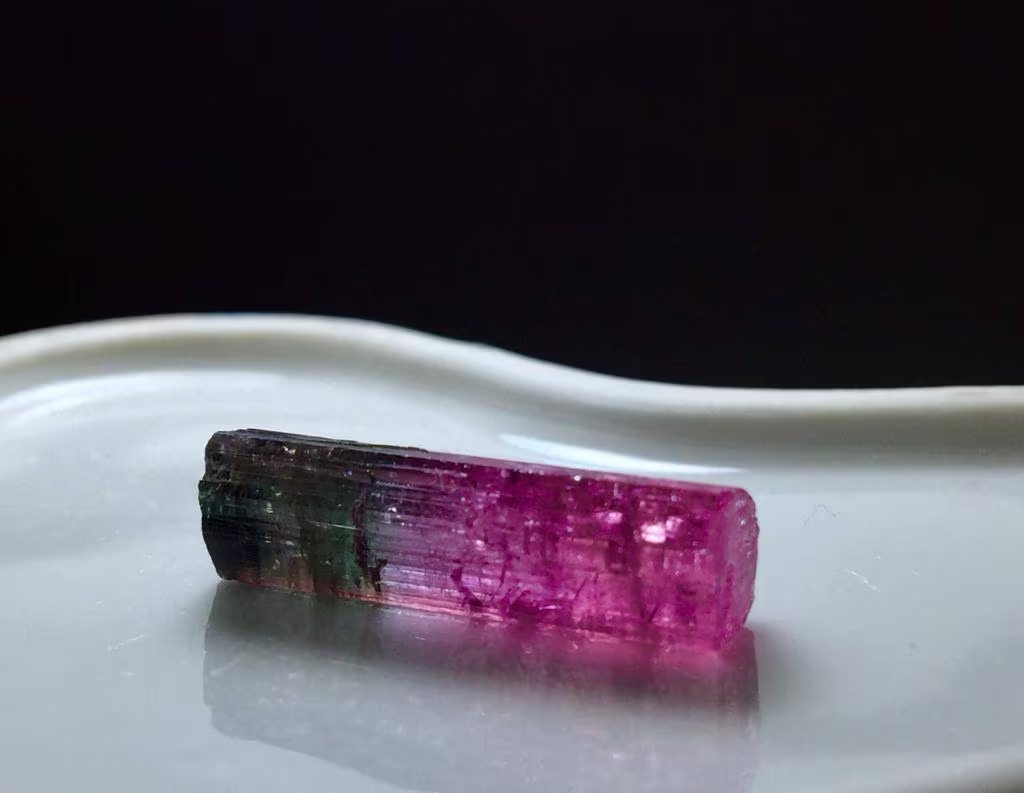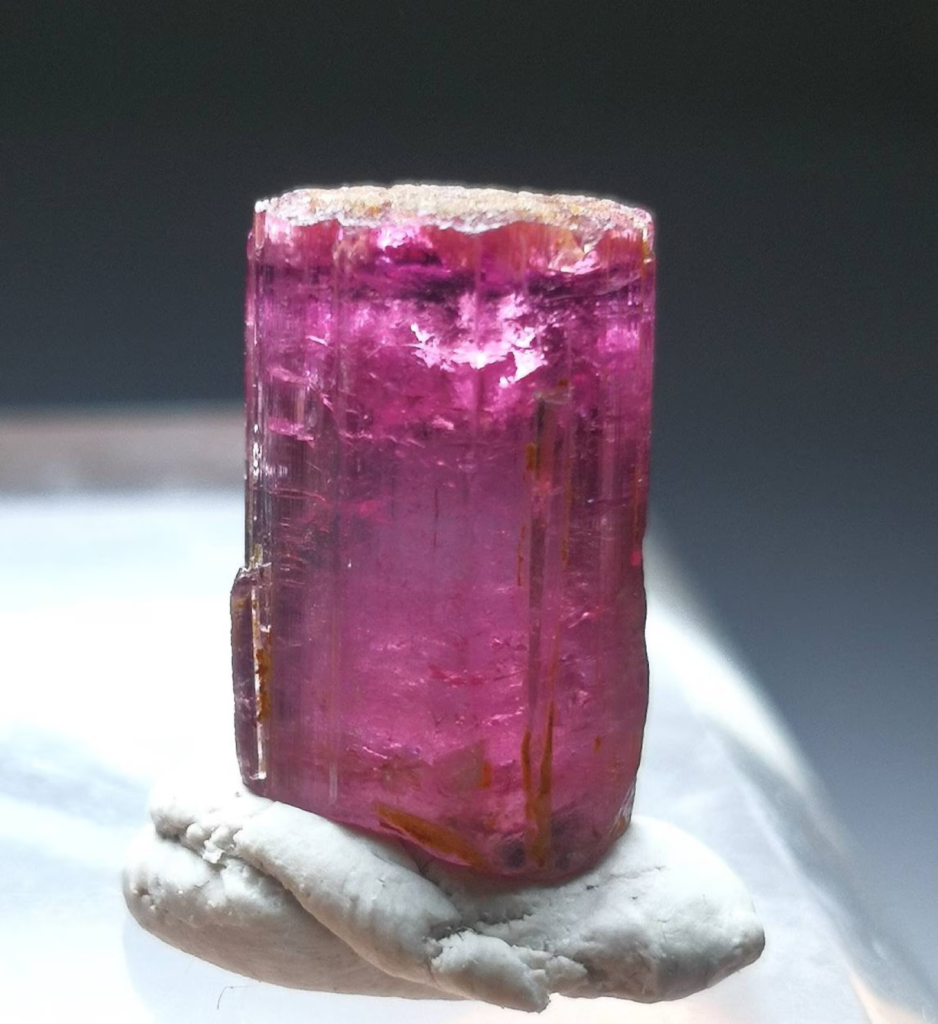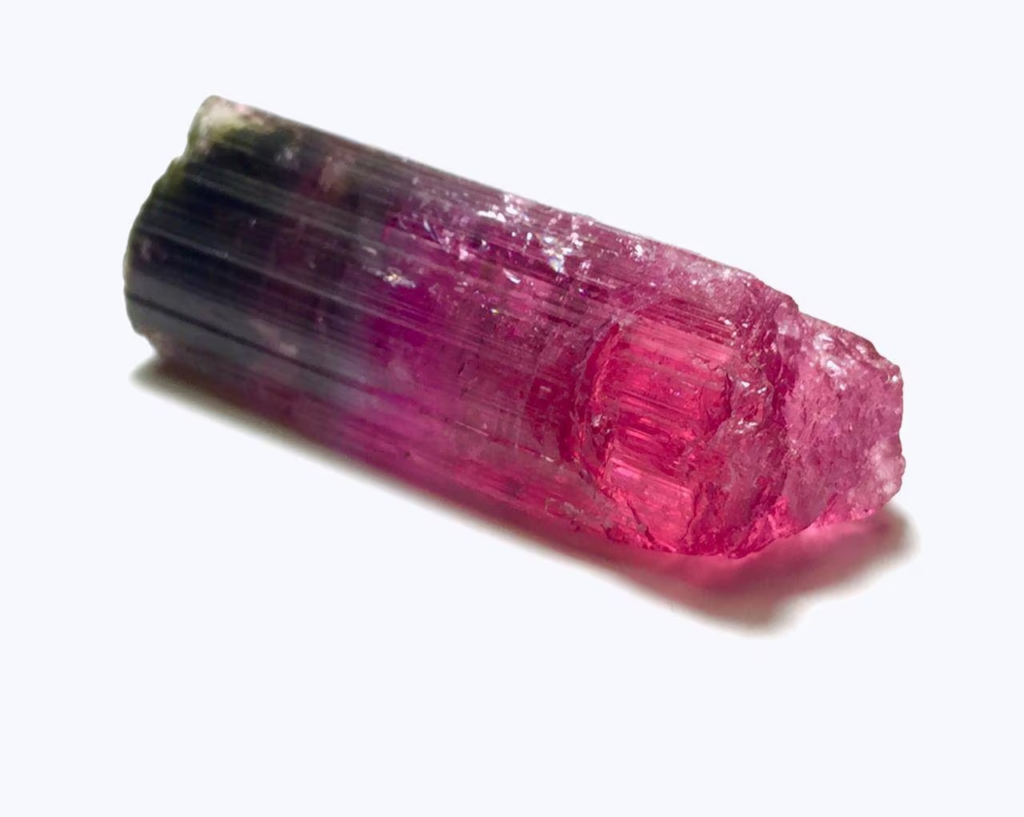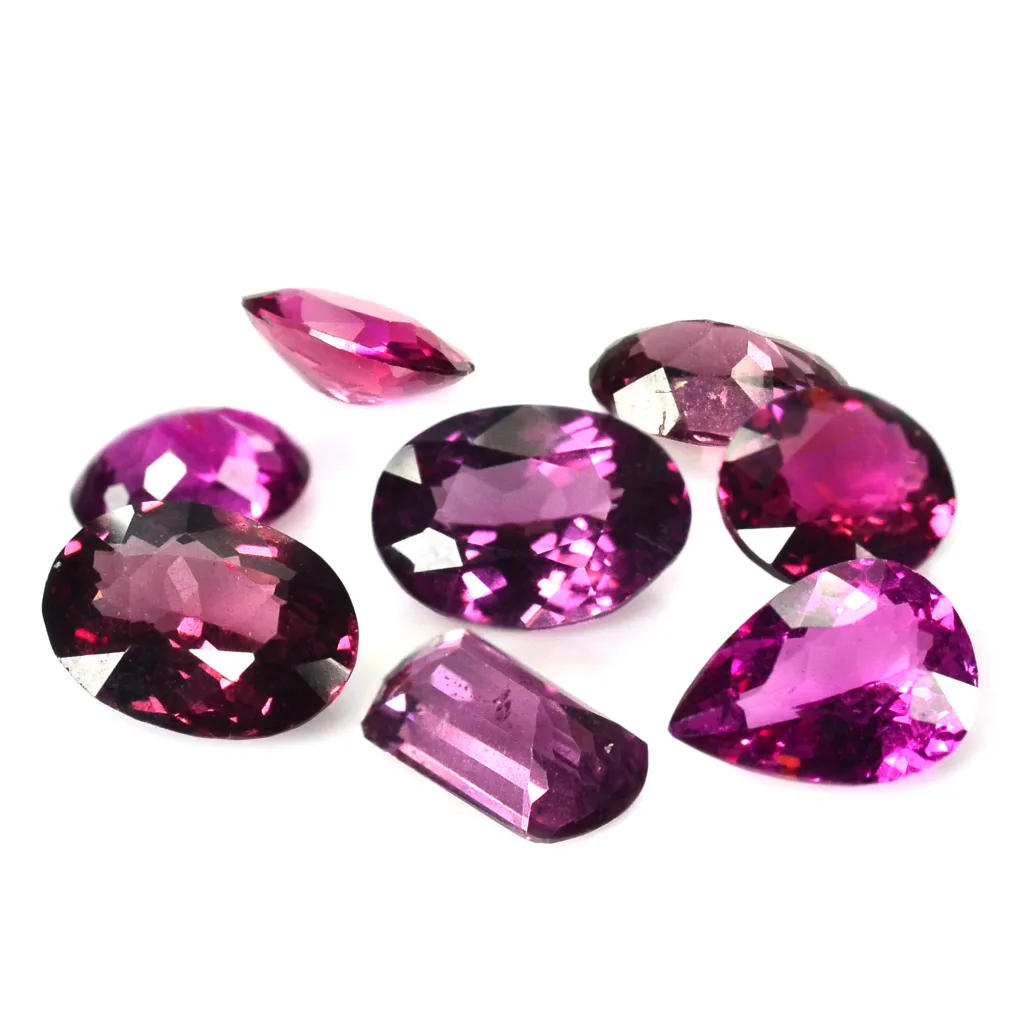Tourmaline is a semi-precious gemstone known for its wide array of colors and unique properties. It belongs to a complex group of boron silicate minerals with varying chemical compositions, resulting in a diverse range of colors including black, brown, green, blue, pink, and purple. Tourmaline crystals often exhibit a prismatic structure and can be found in various geological formations worldwide.

Purple Tourmaline:
Purple tourmaline, also known as “rubellite,” is a variety of tourmaline distinguished by its vibrant shades of purple and pink. It derives its color from traces of manganese within its crystal structure. Purple tourmaline is highly prized for its intense hue and can range from delicate lavender tones to deep magenta shades.
One of the most captivating aspects of purple tourmaline is its rarity and exclusivity. While tourmaline in general is relatively abundant, high-quality purple specimens are much less common, making them highly sought after by gem collectors and enthusiasts alike.
Importance and Significance:
Purple tourmaline holds both aesthetic and symbolic significance. From an aesthetic standpoint, its rich color and exceptional clarity make it a desirable choice for use in jewelry, particularly in rings, pendants, and earrings. Its vivid hues add a touch of elegance and sophistication to any piece, making it a popular choice for both contemporary and vintage designs.
Symbolically, purple tourmaline is associated with qualities such as love, compassion, and spiritual growth. It is believed to resonate with the heart chakra, promoting harmony and emotional balance. Many individuals turn to purple tourmaline for its purported ability to inspire feelings of warmth, empathy, and unconditional love.
Overall, purple tourmaline occupies a special place in the world of gemstones, captivating admirers with its beauty while also carrying deeper symbolic meanings that resonate with the human spirit.
Geological Formation and Occurrence

Purple tourmaline, like other varieties of tourmaline, forms through a combination of geological processes involving heat, pressure, and the presence of specific chemical elements. Here’s an overview of its geological formation and occurrence:
- Primary Deposits: Tourmaline typically forms in pegmatites, which are coarse-grained igneous rocks that form from the slow cooling of magma deep within the Earth’s crust. Pegmatites often contain a variety of minerals, including quartz, feldspar, and mica, as well as trace elements like boron, lithium, and manganese—essential components for tourmaline formation.
- Metamorphism: Tourmaline can also form under conditions of regional metamorphism, where existing rocks undergo changes due to intense heat, pressure, and chemical reactions. During metamorphism, pre-existing tourmaline crystals may recrystallize or new tourmaline crystals may grow in response to changing geological conditions.
- Hydrothermal Processes: In some cases, tourmaline can also form through hydrothermal processes, where hot, mineral-rich fluids circulate through fractures and faults in the Earth’s crust. These fluids can transport and deposit dissolved elements, including those necessary for tourmaline formation, in the cracks and cavities of existing rocks.
- Secondary Deposits: After formation, tourmaline crystals may be released from their primary host rocks through erosion, weathering, and other geological processes. These liberated crystals can then be transported by rivers, streams, and glaciers and eventually accumulate in sedimentary deposits such as alluvial fans, riverbeds, and gravel beds.
- Global Occurrence: Purple tourmaline can be found in various geological settings around the world. Some notable sources include Brazil, Madagascar, Nigeria, Mozambique, Afghanistan, and the United States (California and Maine). Each location may produce tourmaline crystals with unique characteristics influenced by local geological conditions and mineral compositions.
- Mining and Extraction: Extracting tourmaline from its host rock involves mining operations that may range from small-scale artisanal mining to large-scale industrial mining. Once extracted, the rough tourmaline crystals undergo sorting, cutting, and polishing processes to prepare them for use in jewelry and other applications.
Overall, the geological formation and occurrence of purple tourmaline involve a complex interplay of geological processes operating over vast timescales, resulting in the creation of this beautiful and valuable gemstone.
Physical Properties

Purple tourmaline, also known as rubellite, possesses a variety of physical properties that contribute to its beauty and desirability as a gemstone. Here are some key physical properties of purple tourmaline:
- Color: Purple tourmaline exhibits a range of purple and pink hues, ranging from delicate lavender shades to deep magenta tones. The color is often caused by trace amounts of manganese within the crystal structure.
- Crystal System: Tourmaline belongs to the trigonal crystal system, specifically the hexagonal division. Its crystals typically form prismatic structures with vertically striated faces.
- Hardness: Purple tourmaline has a hardness of 7 to 7.5 on the Mohs scale, making it relatively durable and suitable for everyday wear in jewelry.
- Luster: It has a vitreous to subadamantine luster when polished, giving it a brilliant shine and enhancing its attractiveness as a gemstone.
- Transparency: Purple tourmaline can range from transparent to translucent, with higher-quality specimens typically exhibiting greater transparency and clarity.
- Refractive Index: The refractive index of purple tourmaline ranges from approximately 1.616 to 1.651, depending on factors such as chemical composition and crystal structure.
- Specific Gravity: The specific gravity of purple tourmaline ranges from approximately 3.02 to 3.26, indicating a moderate to slightly above-average density.
- Cleavage and Fracture: Tourmaline typically exhibits poor to indistinct cleavage along the prism faces. Its fracture is usually conchoidal, resulting in smooth, curved surfaces when broken.
- Dispersion: While tourmaline does not display significant dispersion like diamond, it may still exhibit some fire or spectral colors under certain lighting conditions.
- Pleochroism: Purple tourmaline often exhibits pleochroism, meaning it can display different colors when viewed from different angles. This property adds to its visual appeal and makes each gemstone unique.
These physical properties contribute to the allure and versatility of purple tourmaline as a gemstone, making it a popular choice for use in various types of jewelry, including rings, pendants, earrings, and bracelets.
Uses and Applications

Purple tourmaline, known for its vibrant color and unique properties, finds a variety of uses and applications across different industries and practices. Here are some of the primary uses and applications of purple tourmaline:
- Jewelry: Purple tourmaline is widely used in the jewelry industry to create stunning pieces such as rings, necklaces, earrings, and bracelets. Its vivid color and brilliance make it an attractive choice for both contemporary and vintage jewelry designs. Purple tourmaline is often faceted to enhance its luster and beauty, but it can also be used in cabochon cuts to showcase its color and clarity.
- Healing and Metaphysical Practices: Purple tourmaline is believed to possess various metaphysical properties that promote emotional healing, balance, and spiritual growth. It is often used in alternative healing practices such as crystal therapy, meditation, and chakra balancing. Advocates of crystal healing suggest that purple tourmaline can help alleviate stress, anxiety, and negative emotions while enhancing feelings of love, compassion, and inner peace.
- Collector’s Items: High-quality purple tourmaline specimens, particularly those with intense color and exceptional clarity, are highly sought after by gem collectors and enthusiasts. Collectors may acquire rare or unique specimens for their personal collections, appreciating the beauty and rarity of these gemstones.
- Investment: Some individuals view purple tourmaline as an investment opportunity, particularly when it comes to acquiring rare or valuable specimens. While not as widely recognized as traditional investment assets like gold or stocks, certain high-quality tourmaline gemstones may appreciate in value over time, especially as demand increases and the supply becomes more limited.
- Fashion and Accessories: Purple tourmaline can also be used in fashion accessories beyond traditional jewelry. Designers may incorporate tourmaline gemstones into accessories such as hair ornaments, brooches, cufflinks, and tie pins to add a touch of color and sophistication to their creations.
- Art and Décor: Artists and designers may use purple tourmaline as decorative elements in various art forms, including sculpture, pottery, and mixed media. Its vibrant color and natural beauty can enhance the visual appeal of artistic creations, whether as standalone pieces or incorporated into larger compositions.
Overall, purple tourmaline’s versatility, beauty, and perceived metaphysical properties contribute to its widespread use and appeal across different industries and practices, making it a cherished gemstone valued for both its aesthetic and symbolic qualities.
Geological Locations Where Purple Tourmaline is Found

Purple tourmaline, also known as rubellite, is found in various geological locations around the world. Some of the notable locations where purple tourmaline is mined or has been discovered include:
- Brazil: Brazil is a significant source of purple tourmaline, particularly in the Minas Gerais region. Mines in Minas Gerais have produced high-quality rubellite tourmaline in various shades of purple and pink.
- Madagascar: Madagascar is renowned for its diverse range of gemstones, including purple tourmaline. Deposits of rubellite tourmaline have been found in areas such as Antsiranana Province and Ilakaka.
- Nigeria: Nigeria is another African country known for its tourmaline deposits, including purple tourmaline. Mines in regions such as Oyo, Nasarawa, and Jos Plateau have yielded purple and pink tourmaline.
- Mozambique: Mozambique is a significant source of tourmaline, including purple tourmaline. Mines in the Alto Ligonha region have produced rubellite tourmaline in various hues, including purple, pink, and red.
- Afghanistan: Afghanistan is known for its rich deposits of gemstones, including tourmaline. Purple tourmaline has been found in mines in the Nuristan Province and other regions of the country.
- United States: Several states in the U.S. have produced purple tourmaline, albeit in smaller quantities compared to other sources. California, particularly the Pala district, and Maine have yielded purple and pink tourmaline.
- Mozambique: Mozambique has become increasingly known for its rubellite tourmaline, including purple varieties. Mines in various regions of the country, such as Alto Ligonha, produce high-quality purple and pink tourmaline.
- Nigeria: Nigeria is also recognized for its tourmaline deposits, with occurrences of purple tourmaline found in areas like Oyo, Nasarawa, and Jos Plateau.
These are just a few examples of the geological locations where purple tourmaline has been found. Each location may yield tourmaline with unique characteristics influenced by local geological conditions, resulting in variations in color, clarity, and quality.





































